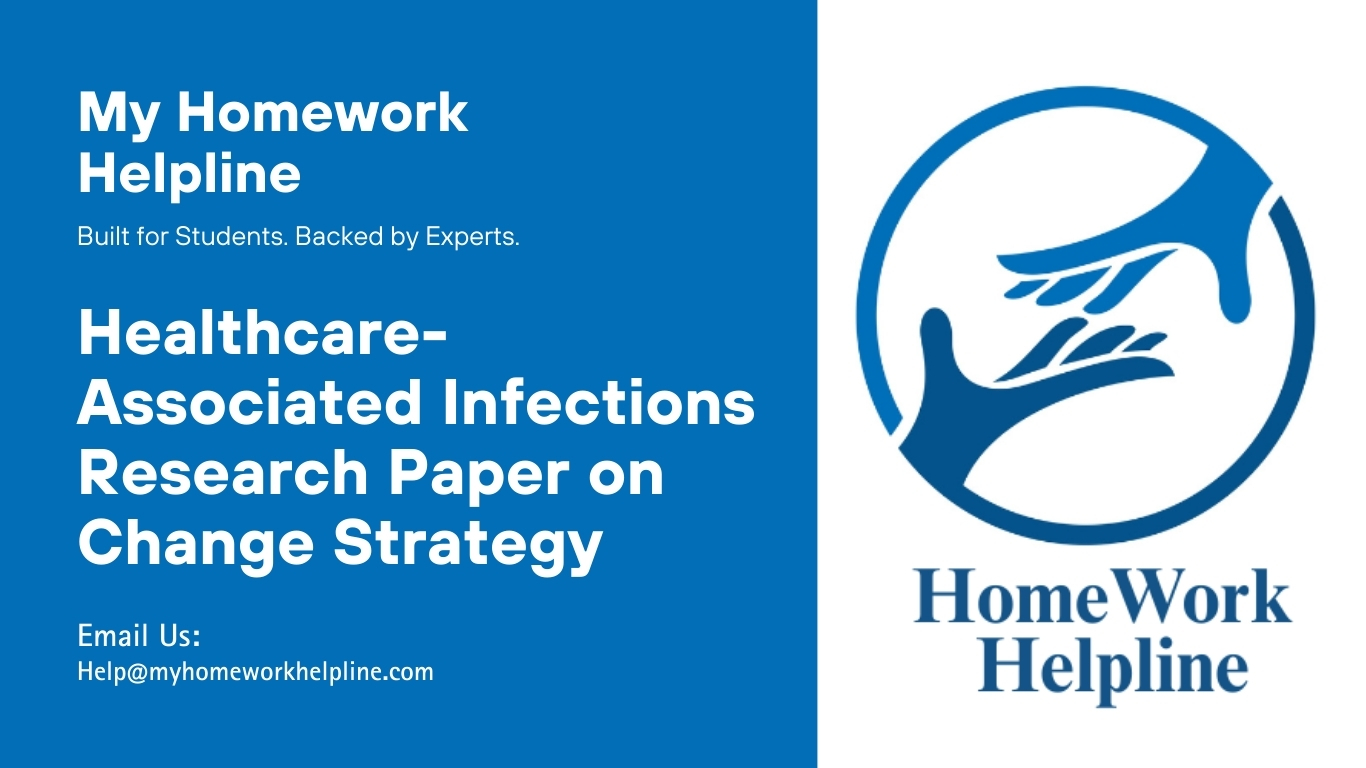Change Strategy and Implementation: Reducing Healthcare-Associated Infections
Introduction
The occurrence of complications due to healthcare-associated infections (secondary infections) continues to rise in the United States. The term healthcare-associated infections refer to infections patients acquire while receiving treatment in healthcare facilities. According to CDC (2014), healthcare-associated infections may be catheter-associated, central line-associated, and ventilator-associated infections. In addition, the infections may occur during surgeries or at surgeries site. The secondary infections normally make the health situation of admitted patients worse with some cases leading to death (Peng, 2020). The secondary infections may prolong a patient’s stay at a health facility which may result in additional costs based on the additional therapeutic and diagnostic interventions.
If you’re working on a complex healthcare-associated infections research paper and need expert guidance, our nursing homework helpline is here to support you. Get tailored assistance with assignments, evidence-based practice essays, and change strategy implementation plans. Visit our nursing homework helpline today for professional academic help designed to improve your grades, save you time, and strengthen your nursing research skills.
Despite the increase in medical treatment and services in outpatient settings observed recently, the impact of secondary infections is on the rise. For instance, a report by the Institute of Medicine highlighted that 12%-84% of secondary infections due to surgery were detected after the patients were discharged from health care, with the detection happening within 21 days after the surgical operations (Collins, 2011). This paper reviewed the literature and identify strategies that can be improved and implemented to help improve the current situation associated with complications from healthcare-based infections.
Change Strategies
The most common secondary infections that affect hospitalized patients are based on surgical complications, adverse drug events, and nosocomial infections. The following table represents the number of patients as well as additional costs impacted by the adverse events associated with secondary infections according to a report by the Institute of Medicine (Collins, 2011).
Table 1:Data table (Collins, 2011).
| State of Secondary Infections | Patients Affected (Yearly) | Additional Costs (Yearly) | Deaths (Yearly) |
| Current State | 2 million | $4.5–5.7 billion | 90,000 deaths |
| Desired State | Below 100,000 | Below $50 million | Below 1,000 |
The current trend of secondary infections as represented in table 1 is traumatizing. The goal of this paper was to establish infection control strategies that may help decrease the current trend highlighted in table 1. The change strategies discussed below may help improve patient safety in healthcare facilities, reducing the additional costs and mortality rate trend as highlighted in the desired state in table 1.
Hygiene
Enforcing hygiene is one of the most effective strategies that can help reduce the transmission of infection within a healthcare setting. According to WHO, proper hand hygiene helps prevent most secondary infections that are healthcare-associated infections (WHO, 2023). Health professionals should ensure everyone in the health facilities maintain personal hygiene by enforcing actions simple as washing hands consistently to prevent transmission of pathogens. Health facilities should always ensure resources such as hand soaps and alcohol-based sanitizers are readily available and accessible for all patients and health professionals. Hand hygiene policies that enforce frequent hand washing should be established and enforced in all healthcare facilities to help prevent the spread of pathogens responsible for secondary infections. In addition, healthcare facilities should promote and monitor hand washing. Enforcing such policies will help build a hand-washing culture in healthcare facilities. Hand washing culture will help prevent the additional costs and deaths based on the treatment of secondary infections in hospital settings as the transmission will be prevented.
The environment of healthcare facilities contains diverse pathogenic microorganisms that come from patients’ wounds or intact skin. This leads to contamination of surfaces such as health care professionals’ uniforms, gloves, blood pressure cuffs, and beddings among other health care equipment. In addition, healthcare surfaces and equipment can also be contaminated with pathogenic organisms. The strategies that can improve the hygiene of the health environment include terminally cleaning rooms after the patient’s discharge. In addition, the surfaces of rooms with patients as well as those that are empty need to be cleaned on a regular basis using alcohol-based detergents. The health care equipment should be cleaned and sterilized before, during, and after patient care on a regular basis (Collins, 2011). In addition, healthcare professionals should be trained to avoid unnecessary hand contact in healthcare settings. These strategies can help reduce direct or indirect cross-contamination responsible for secondary infections. For instance, maintaining the cleanliness of surfaces helps prevent the spread of the Coronavirus pandemic in hospital settings globally. In addition, patients with infections from organisms that are drug resistant are required to be handled using additional precautions to reduce transmission risks.
Protective Equipment
The proper use of personal protective equipment such as face masks, gloves, and gowns is considered one of the most effective infection control practices responsible for reducing the transmission of infectious organisms from patients to health workers and from the health workers to patients. Personal protective equipment popularly known as PPE help prevent exposure of health workers to potentially infectious that may be present in patients’ body fluids, wounds, or even intact body skin. Leaders, practitioners, and health administrators should ensure health workers receive education and training on the proper use of PPE in order for the health workers to protect themselves as well as prevent transmission of infections in hospital settings. In addition to the proper use of PPE, health workers should remove the PPE after attending to a patient. PPE such as face masks and gowns are prone to wear resulting in the need to replace them frequently. The outbreak of Coronavirus in 2020 highlighted how useful PPE was in preventing transmission (Peng, 2020). Proper use of PPE by health workers can help reduce mortality rates based on complications due to secondary infections in healthcare settings. In addition, the safety of patients can be improved by enforcing policies that ensure the usage of PPE such as face masks by patients as well in healthcare facilities.
Isolation
Isolation is an effective strategy to prevent the transmission of an infection in a hospital setting. This is not a common practice, especially for healthcare facilities with limited resources such as hospital rooms and equipment (Mehta et al., 2014). The health care workers, health administrators, and leaders should ensure patients who are carriers of an epidemic strain of bacterium or with communicable diseases are properly isolated to prevent transmission to other patients and health workers. Proper isolation should be enforced by ensuring the proper type of isolation is implemented based on the type of infection. The isolation rooms should have tight-fitting windows and doors with positive-pressure and negative-pressure ventilations. The health workers who are responsible for handling such patients should be trained and monitored to ensure effective infection control practices.
Leadership
Healthcare workers may perform medical errors leading to undesired adverse events such as complications of the infection or condition being treated or even death. Many medical errors are attributed to system problems (Raka, 2010). Healthcare workers may commit medical errors that expose patients to exogenous microorganisms. Leaders such as practitioners and institution administrators are responsible for the reduction of secondary infection risk. Leaders are responsible for the collective behaviors of health facilities and they need to collaborate with health workers and patients to improve the safety of patients as well as health professionals. Leaders need to establish change that prevents infection transmission to improve the health care of patients. Healthcare workers need to be effectively communicated with the best evidence-based practices they should observe while handling patients in a hospital setting. Leaders need to ensure health workers and patients have access to information and resources regarding infection control practices. Leaders of healthcare institutions should enforce and monitor these infection-control practices. In addition, the leaders should be role models by implementing infection-control practices such as hand hygiene. The leaders should also ensure there are enough healthcare workers in a given facility to prevent overworking the healthcare professionals.
Conclusion
Healthcare-associated infections have affected many hospitalized patients globally. In the United States, about 2 million patients are infected by healthcare-associated infections with additional costs of about $4.5 billion and nearly 90,000 deaths every year according to a report by the Institute of medicine. In order to address this negative trend, the proposed change strategies include maintaining the hygiene by implementing policies and practices that include activities such as consistent hand washing, cleaning of surfaces and medical equipment regularly with alcohol-based detergents, proper use of PPE, and establishing proper leadership to initiate and enforce the infection control strategies. The change strategy includes monitoring the infection control strategies to ensure they are properly implemented, leading to a culture within healthcare facilities that can improve the safety of patients as well as that of healthcare providers.
References
CDC. (2014). Types of Healthcare-associated Infections. Retrieved from: https://www.cdc.gov/hai/infectiontypes.html
Collins, A. S. (2011). Preventing health care–associated infections. Retrieved from: https://www.ncbi.nlm.nih.gov/books/NBK2683/#:~:text=Proper%20use%20of%20personal%20protective,from%20the%20health%20care%20worker.
Mehta, Y., Gupta, A., Todi, S., Myatra, S. N., Samaddar, D. P., Patil, V., … & Ramasubban, S. (2014). Guidelines for prevention of hospital acquired infections. Indian journal of critical care medicine: peer-reviewed, official publication of Indian Society of Critical Care Medicine, 18(3), 149.
Peng, J., Xu, L., Wang, M., & Qi, Y. (2020). Practical experiences on the prevention and treatment strategies to fight against COVID-19 in hospital. QJM: An International Journal of Medicine, 113(8), 598-599.
Raka, L. (2010). Prevention and control of hospital-related infections in low and middle income countries. The Open Infectious Diseases Journal, 4(1).
WHO. (2023). Hand hygiene. Retrieved from: https://www.who.int/teams/integrated-health-services/infection-prevention-control/hand-hygiene

